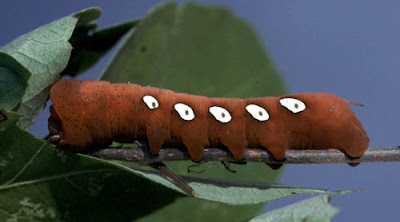 |
| Monarchs down under - shredding milkweed in Auckland - CB |
While hearing all about our friends' Chris and Deb Barnhart's recent travels to New Zealand, I was astonished to see photographs of large populations of our beloved monarch butterflies,
Danaus plexippus. It turns out that the migrations we follow as a marker of our environmental health are just a small part of their travel itinerary.
 |
| Monarch distribution in orange (arrow points to New Zealand ) - Wikipedia |
 |
| "Easy with the hands, mate!" - CB |
For those whose geography is a little rusty like mine, New Zealand is made up of two long large islands southeast of Australia. It is the southernmost home of "our" monarchs. The map labels above suggest their earliest arrival times. They are distributed in many South Pacific islands as well as Australia. Now notice the small yellow circles in the Atlantic Ocean and the southern area of Spain.
"Our monarch"is
D. plexippus while a sister species
Danaus erippus, occurs only in the lower 3/4 of South America. Its appearance and genome is nearly identical to
D. plexippus.
The two are sexually incompatible, meaning that they don't reproduce
when mated together and therefore considered separate species.
Wikipedia
According to
Monarchlab.org, our monarchs arrived in North America from a migratory ancestor, common to both
D. plexippus and
D. erippus.
When the last ice-age began receding 20,000 years ago, "the monarch population
occupying the southern USA and northern Mexico began to grow and expand
their range and migration annually. These expansions were stimulated by
the abundance of milkweed that was growing, exploiting the novel habitat
uncovered by the glacial recession. The population underwent three
separate dispersions into South America, westwards to Oceania and
Australia, and east across the Atlantic"
"Monarchs are native to North and South America, but spread throughout
much of the world in the 1800's, though recent analysis supports
earlier dispersal (Kronforst et al. 2014)). They were first seen in
Hawaii in the 1840's, and spread throughout the South Pacific in the
1850's-60's. In the early 1870's, the first monarchs were reported in
Australia and New Zealand. Monarchs also inhabit Portugal and southern
Spain along the Iberian Peninsula, and the Mediterranean habitat offers a
suitable environment for monarch butterflies to proliferate."
I asked Chris how they got to New Zealand, I was startled when he said by airplane. It turns out that he meant
their trip and even he doesn't have the answer for the monarchs' transportation.
Monarchlab has a lot of information on the various hypothesis as well as the relationship to the arrival of milkweed.
Monarchs are recent exotic arrivals but welcomed species in New Zealand and other locations across the South Pacific. They have few enemies and milkweed resources are available. The climate allows them to thrive without the long commutes of our native monarchs. Since they spread freely without causing any appreciable harm, some Australians refer to them lovingly as
"flying weeds".
The wide separation and relatively recent separation of colonies gives genetic science an opportunity to study the effects of newly implanted small populations, the so called founder effect.
Berkeley.edu describes this as "population
bottlenecks occurring when a population's size is reduced for at least
one generation." In this case, if only a few monarchs make the trip across the wide ocean expanse, they might be limited in genetic diversity compared to the population as a whole. Their article gives examples of this.
Some final thoughts from Chris Barnhart:
"Monarchs are in NO danger of extinction as a species anytime soon. Monarchs are doing just fine, along with the cabbage butterfly, starlings, cockroaches and others that have been made global by human activity. Humans planting milkweeds let monarchs colonize places they never could have survived before. Yes, we should care about keeping monarchs abundant in the US, because the migration is a wonderful thing. But the monarch is not the only amazing species and certainly not the most endangered or the most in need of attention in our area.
We should be planting more than milkweeds. Planting an oak tree will help over 500 species of native insects and the birds that feed on them. Milkweeds and monarchs might be effective poster children, but I think that too many people are missing the bigger picture. Doug Tallamy’s books and websites are a great source of how-to information on native host plants for butterflies and other wildlife. We have lots of examples in the Roston Butterfly House. If you plant for them, they will come!"
============
Update 3-17-2019
Monarchs have lost the long-distance migration record.
Science confirms that Painted Ladies make an annual journey of 7,500 miles from Spain over the Sahara desert to southern Africa!
For a fascinating Australian view of monarchs, or Wanderers as they call them, check out this web site. It describes their migration strategies that vary with regional climates, with some "over-wintering" by hanging from the branches of trees in large clusters of thousands of butterflies.





























